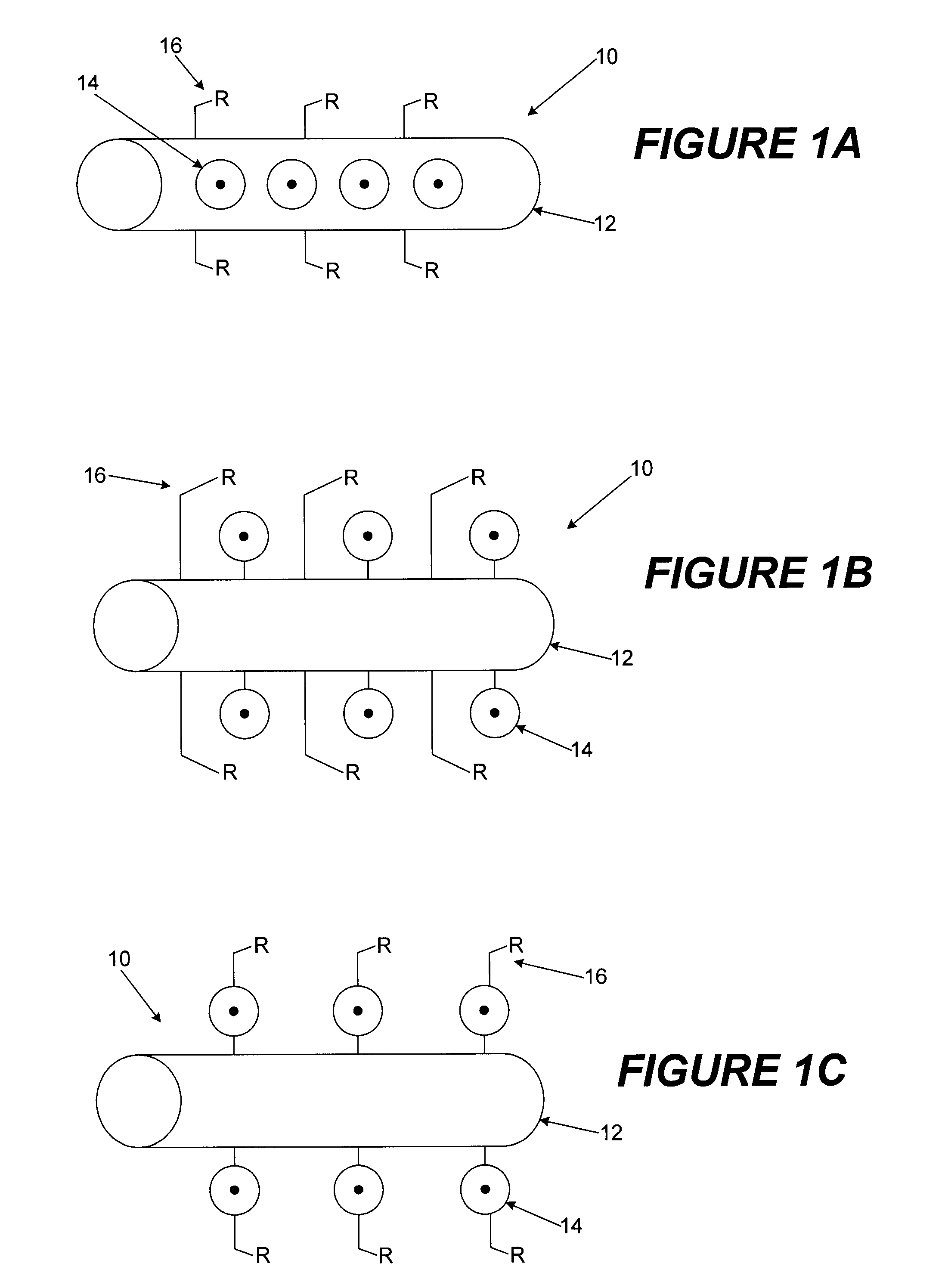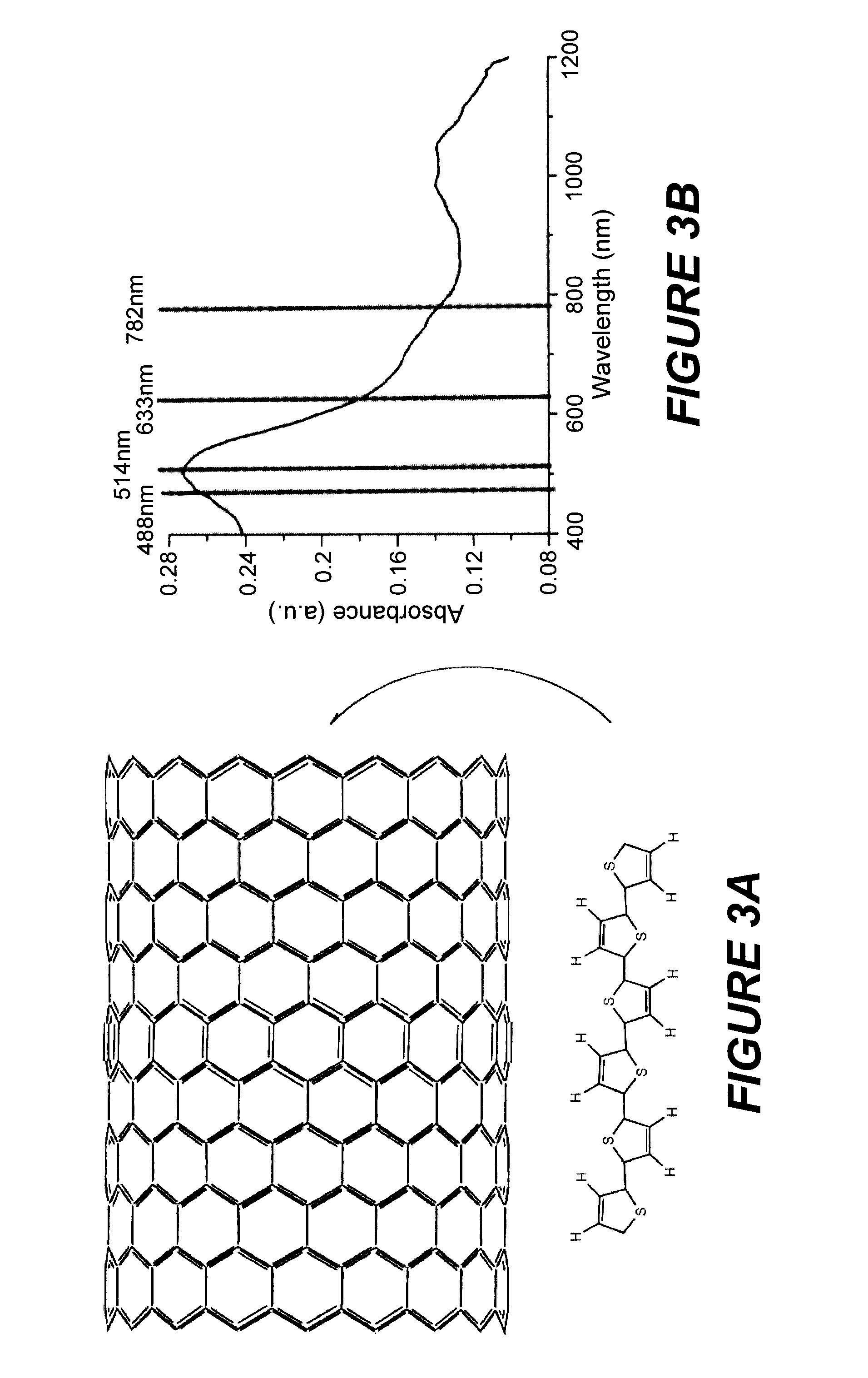Raman scattering nanoprobes
a nano-probe and nano-scale technology, applied in the field of nano-scale spectroscopy and imaging, can solve the problems of lack of sensitivity relative to other spectroscopic techniques, unambiguous molecular detection without loss of sensitivity, and the use of raman molecular probes is rarely found in commercial applications, so as to facilitate the dispersion or solubility of the probe and promote the dispersion of the prob
- Summary
- Abstract
- Description
- Claims
- Application Information
AI Technical Summary
Benefits of technology
Problems solved by technology
Method used
Image
Examples
example 1
Probes of the Type Oligothiophene@SWNT
a) Probes α-Sexithiophene@SWNT
[0088]The assembly of α-sexithiophenes (6T) in carbon nanotubes is known in the prior art. [M. A. Loi, J. Gao, F. Cordella, P. Blondeau, E. Menna, B Bartova, C. Hébert, S. Lazar, G. A. Botton, M. Milko, et C. Ambrosch-Draxl, Adv. Mater. 22, 1-5 (2010)]FIG. 3A illustrates the encapsulation of 6T in the nanotube and shows schematically the large size of the capsule relative to the molecules.
[0089]Measurements of absorption and Raman scattering on the powder form of 6T@SWNT composites, of a solution containing them and on the samples of individual 6T@SWNT composites deposited on a silicon substrate, were done by the inventors. To disperse the 6T@SWNT deposits in a solvent solution, the samples were functionalized by chemical oxidation in concentrated HNO3. This step permits the attachment of COOH functions on the exterior of the nanotubes. The absorption spectrum of the functionalized 6T@SWNT powder, shown in FIG. 3B, ...
example 2
Encapsulated Raman Scattering Probes with Commercial Molecules
[0098]Multiple capsule probes can be made using commercial molecules. The choice of a Raman-active molecule is made based on the Raman resonance energy and the spectral characteristics necessary for a given application. There is a wide variety of different molecules available, and the inventors have worked with such molecules as methylene violet B and diethylthiodicarbocyanine iodide (DTDCI).
[0099]a) Methylene Violet B@SWNT Probes
[0100]Capsule probes prepared with methylene violet B have been shown to provide a good response in Raman scattering. Methylene violet B possesses the following structure:
[0101]The process of fabrication follows the general steps described. For the encapsulation step, an abundance of the SWNT and the methylene violet B are dispersed in heptane and the suspension is treated with ultrasound for about two minutes. The suspension is then agitated overnight to reflux, and is subsequently purified by s...
example 3
Toluidine Blue—DWNT Probes (External Dye Attachment)
[0107]An example of a capsule probe such as that shown in FIG. 1B was achieved using toluidine blue as the Raman-active molecule. For this probe, the Raman-active dye is chemically attached by a covalent reaction to the exterior of the nanotubes and, more particularly, to the external surface of the capsule.
[0108]The fabrication method uses one variation of the general method presented above. Because the step of encapsulation is not necessary for these probes, that step is omitted, and the process goes directly to the chemical attachment of the dye to the capsule. For the toluiding blue-DWNT probe, one part double wall nanotubes (DWNT) and four parts toluidine blue are placed in a round-bottom flask. The flask is purged with nitrogen and heated to 130° C. Thirty parts of isoamylnitrite are then added to the mixture and the reaction proceeds for 24 hours under vigorous agitation. The residue that contains toluidine blue-DWNT is rins...
PUM
| Property | Measurement | Unit |
|---|---|---|
| excitation wavelengths | aaaaa | aaaaa |
| excitation wavelengths | aaaaa | aaaaa |
| excitation wavelengths | aaaaa | aaaaa |
Abstract
Description
Claims
Application Information
 Login to View More
Login to View More - R&D
- Intellectual Property
- Life Sciences
- Materials
- Tech Scout
- Unparalleled Data Quality
- Higher Quality Content
- 60% Fewer Hallucinations
Browse by: Latest US Patents, China's latest patents, Technical Efficacy Thesaurus, Application Domain, Technology Topic, Popular Technical Reports.
© 2025 PatSnap. All rights reserved.Legal|Privacy policy|Modern Slavery Act Transparency Statement|Sitemap|About US| Contact US: help@patsnap.com



